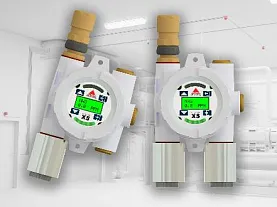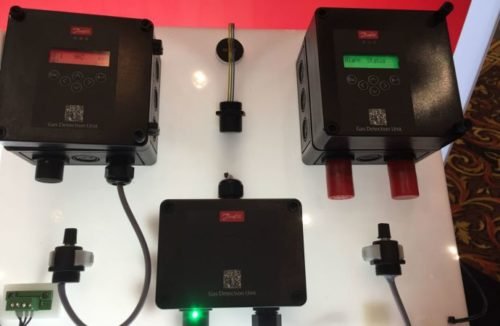
New products, 15 May 2024
 Component manufacturer Danfoss Group is targeting its new digital gas detectors for their potential use in industrial refrigeration facilities that use natural refrigerants, including ammonia and CO2.
James Hower, industrial refrigeration sales manager at Danfoss, led an information session at the IIAR Natural Refrigeration Conference & Expo in March detailing how the company’s latest digital gas detectors can reduce installation and maintenance costs while maximizing safety because of their high degree of accuracy. The detectors are mid-market solutions ideally suited for users of ammonia in particular, he said.
“It’s simpler to use because it is digital,” said Hower. “You can calibrate it without tools.
The detectors have maintenance reminders with alarms built in — features that are lacking in other gas detection systems that have been on the market, he said.
The Danfoss gas detectors allow users to have two different sensors connected to a single controller, which could provide a more streamlined solution for facilities using ammonia-CO2 cascade refrigeration systems, or for those using low-charge ammonia solutions.
Ammonia-CO2refrigeration users could have one sensor programmed for ammonia detection and another for CO2detection, both monitored from a single electrical box, while low-charge ammonia users could have two different sensors programmed for different levels of ammonia detection — one for 0-100 ppm, for example, and another for 1,000-plus ppm.
In order to assist in the deployment of gas detection systems of all types and in all settings, Danfoss also has begun issuing application guides.
There really is no ‘standard’ on where to put gas detectors,” said Hower. “Do you put them near people? Do you put them up high? Down low? By doors? So, we are creating application guides to help guide the market on how to apply gas detection to their plants.
Source: www.r744.com
Component manufacturer Danfoss Group is targeting its new digital gas detectors for their potential use in industrial refrigeration facilities that use natural refrigerants, including ammonia and CO2.
James Hower, industrial refrigeration sales manager at Danfoss, led an information session at the IIAR Natural Refrigeration Conference & Expo in March detailing how the company’s latest digital gas detectors can reduce installation and maintenance costs while maximizing safety because of their high degree of accuracy. The detectors are mid-market solutions ideally suited for users of ammonia in particular, he said.
“It’s simpler to use because it is digital,” said Hower. “You can calibrate it without tools.
The detectors have maintenance reminders with alarms built in — features that are lacking in other gas detection systems that have been on the market, he said.
The Danfoss gas detectors allow users to have two different sensors connected to a single controller, which could provide a more streamlined solution for facilities using ammonia-CO2 cascade refrigeration systems, or for those using low-charge ammonia solutions.
Ammonia-CO2refrigeration users could have one sensor programmed for ammonia detection and another for CO2detection, both monitored from a single electrical box, while low-charge ammonia users could have two different sensors programmed for different levels of ammonia detection — one for 0-100 ppm, for example, and another for 1,000-plus ppm.
In order to assist in the deployment of gas detection systems of all types and in all settings, Danfoss also has begun issuing application guides.
There really is no ‘standard’ on where to put gas detectors,” said Hower. “Do you put them near people? Do you put them up high? Down low? By doors? So, we are creating application guides to help guide the market on how to apply gas detection to their plants.
Source: www.r744.com